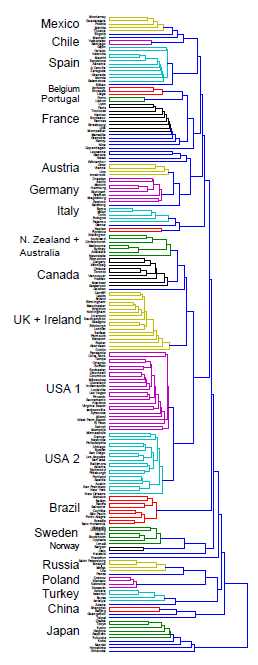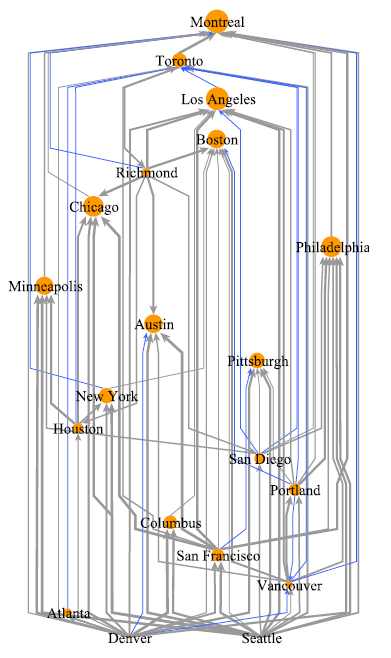| How the Music Flows from Place to Place |
| Written by Alex Armstrong |
| Friday, 13 April 2012 |
|
Is music a world phenomenon or is it spilt into regions with specific preferences? Are there cities that lead the way in finding new popular music while others follow? And what has a flock of pigeons got to do with it? When it comes to music, the US is split into two regions and Canada is out there with its own tastes. For Indie music, Toronto leads the pack; and for hip-hop, Atlanta shows the way. We have so much data on people's preferences and behavior that the problem is what to do with it. For example, last.fm records what music tracks people are listening to and records their genre and geographical location. This is a dataset ripe and ready to reveal how musical taste is spread throughout the world and how new music flows from place to place. However, the analysis needed is complicated and subtle. Two researchers, Conrad Lee and Padraig Cunningham, at University College Dublin have spent a lot of time getting it right and their conclusions are interesting to say the least. They took the data from last.fm and after some preparation and normalizing used it to answer a number of questions. The first was to find out if listening preferences are global. If there are just a few global mega stars that set the trends, then music should follow a global pattern. The answer, in the form of a hierarchical clustering, shows that the musical world is divided into camps that go by language - Anglophone, Spanish, German and so on. This doesn't seem unreasonable, although if you look carefully there are some anomalies such as Switzerland, even its French speaking cities, being in the German group. More interesting is North America split into Canada, which is slightly more like Australia and New Zealand than the US, and the US, which is split into two non-geographically coherent groups. There is no obvious reason for the US being split into two taste groups, so feel free to speculate. Group 2 seems to contain the largest cities and a few of the trendier places.
You can see a higher resolution version in the original paper.
The second question to answer is, "are some cities leaders and others followers"? The approach taken was borrowed from a study of flocking pigeons. To find the leader all you have to do is correlate movements between birds with different time lags. A big positive correlation with a time lag suggests one bird is following another. The same idea can be used to find leaders and followers of musical taste. The result of the analysis are some network diagrams showing how musical preferences flow from city-to-city. The good news is that the results seem sensible in that the method doesn't generate strong loops where city A influences city C, which influences city B, which influences city A. Such a loop would suggest that there are no real leaders and followers. As a check the data was randomized and then such loops did appear - suggesting that the analysis is revealing a real signal in the data. Although, if you take a look at the diagrams (more in the original paper) you might be hard pressed to explain why Montreal is the lead city for Indie Music and for Hip Hop there appear to be three independent leaders - Atlanta, Toronto and Chicago. The analysis for western Europe shows that Paris is the number one Indie leader, but Oslo has its own sub-graph of followers.
Diagram for Indie music in North America
The final question addressed by the researchers is a deep one about the advantage of large city sizes. Recently, it has been popular to speculate that cities scale super linearly in productivity, but linearly or sub-linearly in consumption of services. What this means is that bigger cities should be more efficient and effective cities. (A gross over-simplification - see Urban Scaling and Its Deviations: Revealing the Structure of Wealth, Innovation and Crime across Cities.) So if super-linear scaling is valid, city size should be correlated with degree of leadership. The study discovered that this is only weakly supported with a lower than expected correlation, except in the case of Indie music. There are also lots of examples of big cities that show a lower leadership score than much smaller cities. It seems that size is not the only determinant of influence on musical preferences. Is there any practical value in this sort of study? Consider if you were a music publisher on a low budget. Where would you place your advertising dollars? In a city that was a leader, of course. It is also clear that the same sort of leader analysis could be performed on other consumer products such as books, videos and apps.
More InformationThe Geographic Flow of Music arXiv:1204.2677v1
Comments
or email your comment to: comments@i-programmer.info
To be informed about new articles on I Programmer, subscribe to the RSS feed, follow us on Google+, Twitter, Linkedin or Facebook or sign up for our weekly newsletter.
|
| Last Updated ( Friday, 13 April 2012 ) |





